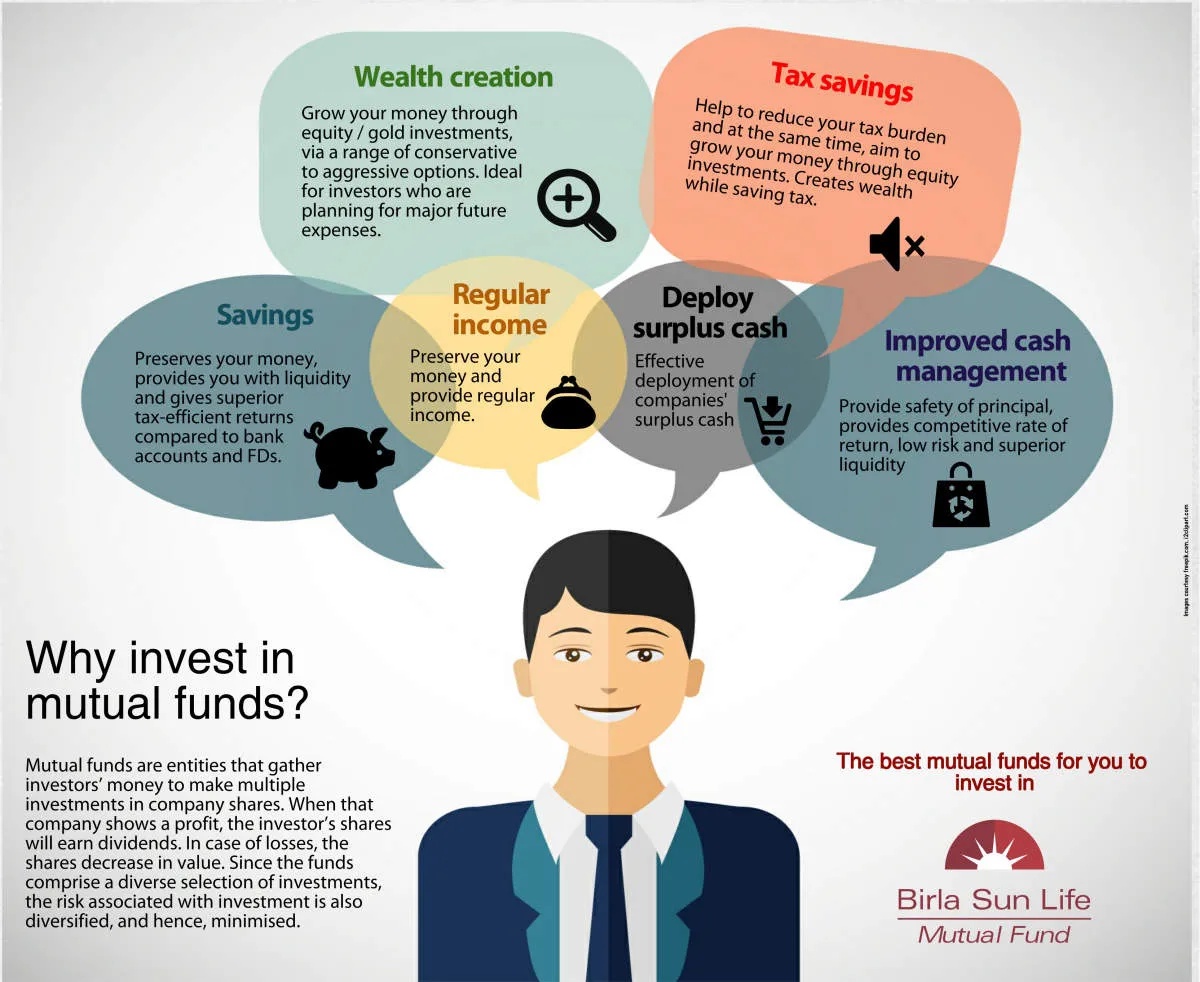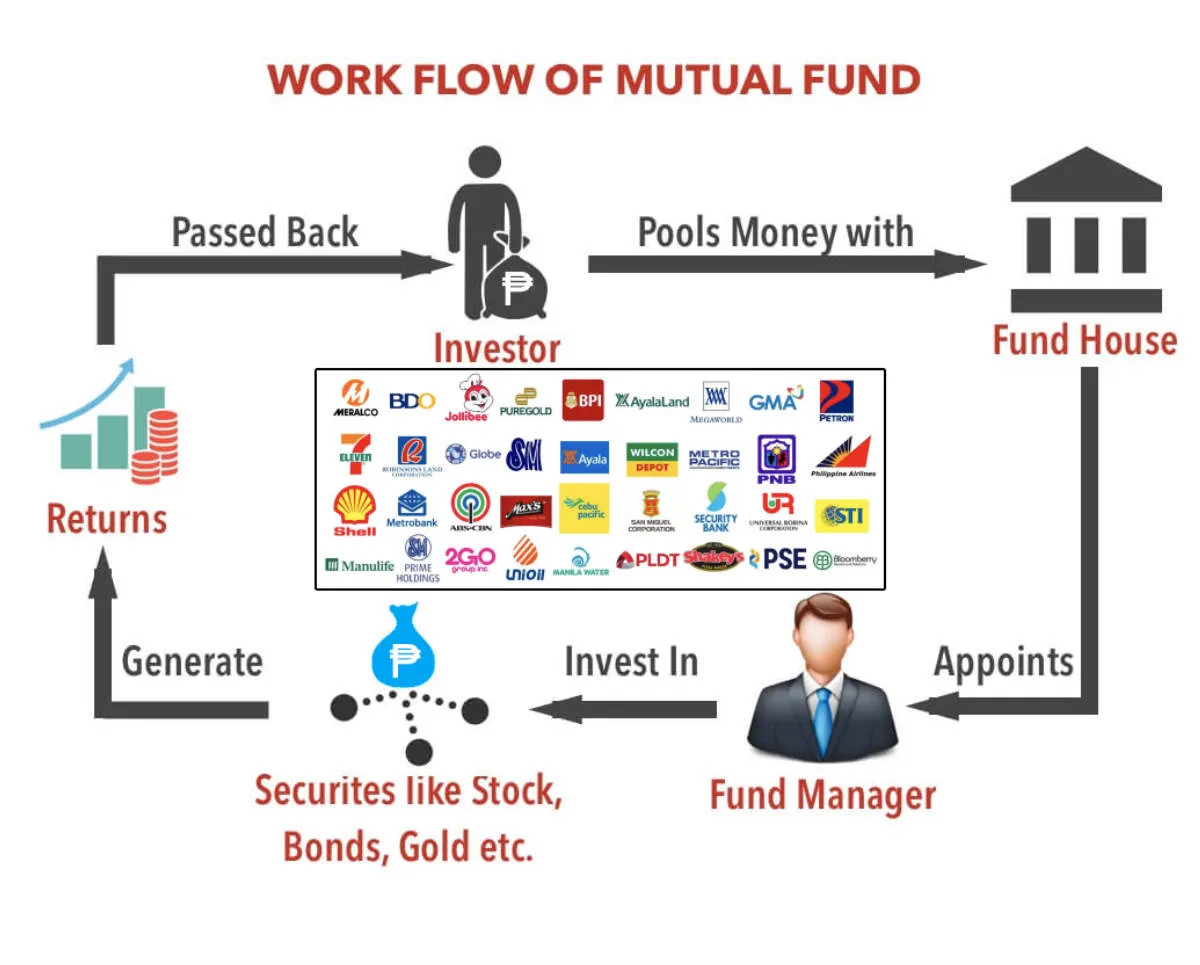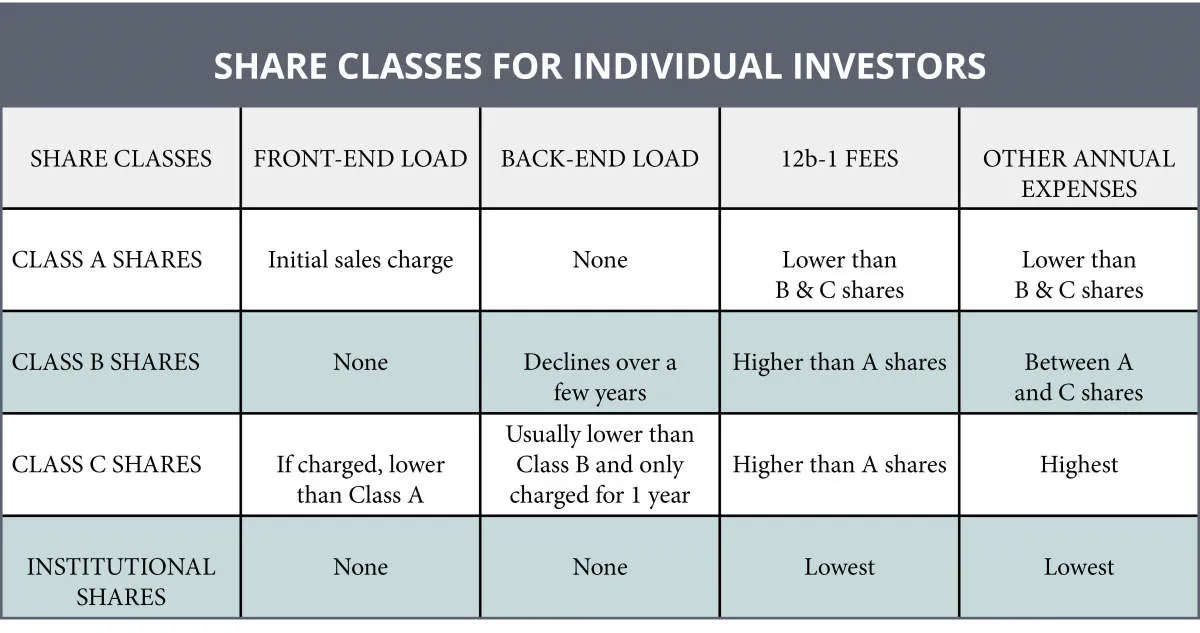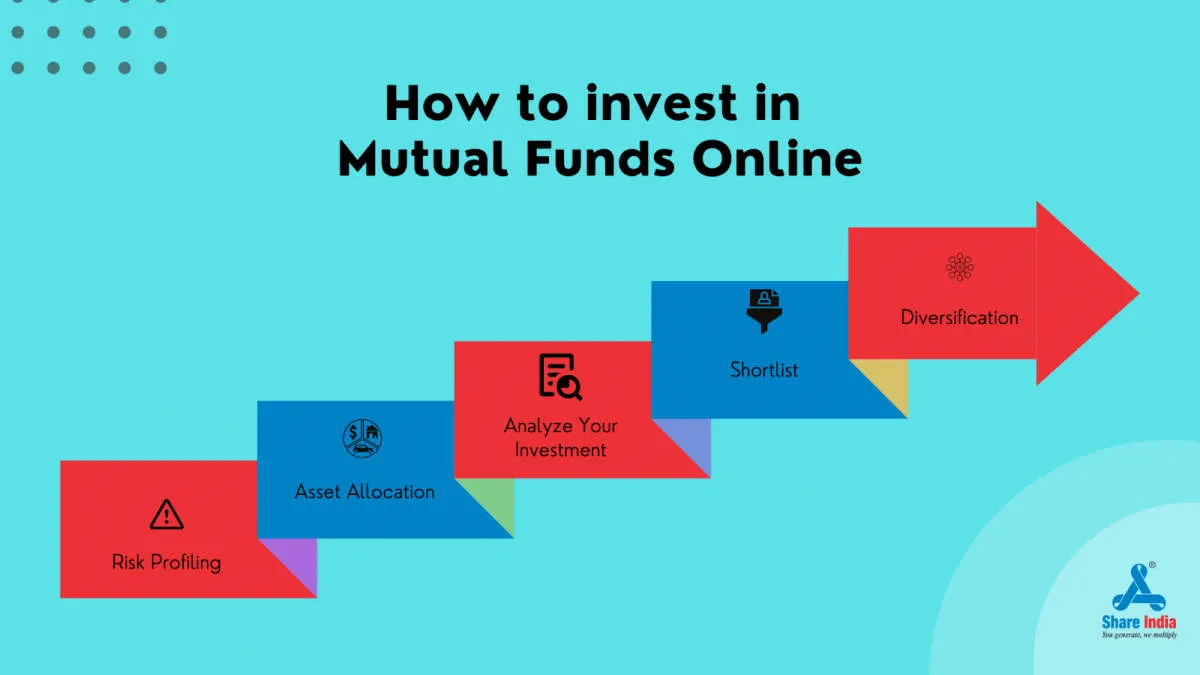Are you new to investing and interested in mutual funds? Learn the basics of how to start investing in mutual funds as a beginner and take the first step towards building wealth through this popular investment option.
What are Mutual Funds?
In simple terms, a mutual fund pools money from many investors and invests it in a diversified portfolio of assets, such as stocks, bonds, or other securities. This collective investment scheme is managed by professional fund managers, who aim to achieve specific investment objectives outlined in the fund’s prospectus.
Imagine a basket containing a variety of fruits. Each fruit represents a different investment, like a company’s stock or a government bond. The basket itself is the mutual fund. When you invest in a mutual fund, you’re buying a share of this basket, giving you exposure to all the fruits (investments) inside.
Key features of mutual funds include:
- Diversification: By pooling money from multiple investors, mutual funds can hold a wide range of assets, reducing the impact of any single investment on your overall portfolio.
- Professional Management: Fund managers use their expertise to make investment decisions on behalf of investors, aiming to achieve the fund’s objectives.
- Affordability: Mutual funds typically have lower minimum investment requirements compared to investing directly in individual securities, making them accessible to a wider range of investors.
- Liquidity: Investors can typically buy or sell shares of mutual funds at the end of each trading day, providing flexibility and ease of access.
Benefits of Investing in Mutual Funds

Investing in mutual funds offers a range of benefits, especially for beginners. Some key advantages include:
1. Diversification
Mutual funds pool money from multiple investors to invest in a diversified portfolio of stocks, bonds, or other assets. This diversification helps reduce risk by spreading investments across various asset classes and companies. Even if one investment performs poorly, others may perform well, mitigating potential losses.
2. Professional Management
When you invest in a mutual fund, you’re essentially hiring a professional fund manager to make investment decisions on your behalf. These managers have the expertise, experience, and resources to research and select investments that align with the fund’s investment objective.
3. Affordability
Mutual funds typically have relatively low minimum investment requirements, making them accessible to a wide range of investors. This allows you to start investing with a smaller amount of capital and gradually increase your investment over time.
4. Liquidity
Mutual funds are generally considered liquid investments, meaning you can buy or sell shares on any business day at the net asset value (NAV). This provides flexibility to access your money when needed.
5. Transparency and Regulation
Mutual funds are subject to strict regulations and disclosure requirements, providing transparency to investors. Fund companies are required to provide regular reports and disclosures about the fund’s holdings, performance, and fees.
Types of Mutual Funds
Before diving into the world of mutual fund investing, it’s crucial to understand the different types available, as each caters to specific financial goals and risk tolerances. Here’s a breakdown of some common categories:
1. Equity Funds
Equity funds primarily invest in stocks of companies. They offer the potential for higher returns over the long term but also come with higher volatility, making them more suitable for investors with a longer investment horizon and a higher risk appetite.
Types of Equity Funds:
- Large-cap funds: Invest in established, large-sized companies.
- Mid-cap funds: Focus on mid-sized companies with growth potential.
- Small-cap funds: Invest in smaller companies with higher growth potential but also higher risk.
- Sector funds: Concentrate investments in a specific industry, such as technology or healthcare.
2. Debt Funds
Debt funds primarily invest in fixed-income securities like bonds and government securities. They generally offer lower returns compared to equity funds but are considered less risky. They are suitable for investors with a lower risk appetite and seeking regular income.
Types of Debt Funds:
- Liquid funds: Invest in short-term debt instruments, offering high liquidity.
- Income funds: Aim for regular income by investing in a mix of debt securities.
- Gilt funds: Invest in government securities, considered the safest debt instruments.
3. Hybrid Funds
Hybrid funds, also known as balanced funds, invest in a mix of equity and debt instruments. This balanced approach aims to provide a moderate level of growth potential with relatively lower volatility compared to pure equity funds. Hybrid funds are suitable for investors seeking a diversified portfolio with moderate risk.
Types of Hybrid Funds:
- Aggressive hybrid funds: Allocate a higher proportion to equities, offering higher growth potential.
- Conservative hybrid funds: Hold a larger portion in debt instruments, providing more stability.
4. Index Funds
Index funds are passively managed funds that track a specific market index, such as the S&P 500 or the Nifty 50. These funds aim to replicate the performance of the index, making them a cost-effective option for investors seeking broad market exposure.
5. Exchange-Traded Funds (ETFs)
ETFs are similar to index funds in that they track a specific index or asset class. However, ETFs are traded on stock exchanges like individual stocks, providing investors with more flexibility in terms of trading throughout the day. ETFs are also known for their low expense ratios.
By understanding the different types of mutual funds available, you can choose the ones that align with your financial goals, risk tolerance, and investment horizon. It’s essential to conduct thorough research and consult with a financial advisor to make informed investment decisions.
How to Choose Mutual Funds

Navigating the world of mutual funds can feel overwhelming, especially for beginners. With countless options available, selecting the right funds for your investment goals and risk tolerance is crucial. Here’s a breakdown to guide you:
1. Determine Your Investment Goals and Risk Tolerance
Before diving into fund options, clearly define your investment objectives. Are you saving for retirement, a down payment on a house, or your child’s education? Your goals will significantly influence your investment timeline and risk appetite.
Risk tolerance refers to your comfort level with market fluctuations. Are you comfortable with potentially higher returns but also the possibility of losing money in the short term (higher risk), or do you prefer slower, steadier growth (lower risk)?
2. Understand Different Mutual Fund Categories
Mutual funds are broadly categorized based on their investment objectives:
- Equity Funds: Invest primarily in stocks, offering higher growth potential but also higher risk.
- Bond Funds: Invest in bonds, generally considered less risky than equity funds but with potentially lower returns.
- Money Market Funds: Invest in short-term debt securities, offering high liquidity and low risk but with lower returns.
- Balanced Funds: Invest in a mix of stocks and bonds, aiming for a balance between growth and stability.
- Index Funds: Track a specific market index, offering low costs and diversification.
3. Research and Compare Funds
Once you know your risk tolerance and preferred fund categories, start researching specific funds. Utilize online tools and resources like Morningstar, Yahoo Finance, or Google Finance to compare funds based on key factors:
- Expense Ratio: The annual fee charged to manage the fund. Lower expense ratios are generally better.
- Historical Performance: Past performance is not a guarantee of future returns, but it provides insight into a fund’s track record.
- Fund Manager: Research the experience and track record of the fund manager.
- Investment Strategy: Understand the fund’s approach to investing and ensure it aligns with your goals.
4. Consider Diversification
Don’t put all your eggs in one basket. Diversifying your investments across different asset classes, industries, and geographies can help mitigate risk. Consider investing in a mix of mutual funds to achieve a well-rounded portfolio.
Steps to Invest in Mutual Funds
Investing in mutual funds is generally straightforward and can be broken down into these key steps:
1. Determine Your Investment Goals and Risk Tolerance:
Before you invest, clarify your financial goals. Are you saving for retirement, a down payment on a house, or your child’s education? Your goals will influence your investment timeline and how much risk you’re comfortable taking.
2. Choose the Right Type of Mutual Fund:
There are numerous types of mutual funds, each with a different investment strategy and focus:
- Equity Funds: Invest primarily in stocks and aim for capital appreciation.
- Bond Funds: Invest in bonds and offer regular income.
- Money Market Funds: Invest in short-term debt securities and are considered low-risk.
- Index Funds: Track a specific market index, such as the S&P 500.
- Target-Date Funds: Automatically adjust their asset allocation as you get closer to a specific retirement year.
3. Select a Fund Family and Open an Account:
Research different fund families (e.g., Vanguard, Fidelity, Schwab) and compare their fees, investment options, and customer service. Once you’ve chosen a company, you’ll need to open an account. This typically involves providing personal and financial information.
4. Choose a Specific Mutual Fund:
Within the fund family you’ve selected, research individual funds that align with your investment goals and risk tolerance. Consider factors like historical performance, expense ratios, and the fund manager’s track record.
5. Decide on Your Investment Amount and Frequency:
Determine how much money you’re comfortable investing initially and whether you’ll make regular contributions (e.g., monthly). Many funds have minimum investment requirements, but these vary.
6. Place Your Investment Order:
Once you’ve made your selections, you can place your investment order online, by phone, or through a financial advisor. You’ll need to provide your account information and the details of the fund you’re purchasing.
7. Monitor Your Investments:
It’s essential to track your mutual fund investments regularly, reviewing their performance and making adjustments to your portfolio as needed to stay aligned with your goals and risk tolerance.
Understanding Mutual Fund Fees

While mutual funds offer a convenient way to invest in a diversified portfolio of stocks, bonds, or other assets, it’s essential to understand that they come with fees and expenses. These fees can impact your overall returns, so it’s crucial to be aware of them before investing.
Types of Mutual Fund Fees
Here are some common types of mutual fund fees:
- Expense Ratio: This is an annual fee charged by the fund to cover its operating expenses, such as management fees, administrative costs, and marketing expenses. The expense ratio is expressed as a percentage of your investment. For example, if you invest $10,000 in a fund with a 1% expense ratio, you’ll pay $100 in fees annually.
- Sales Loads: Some funds charge sales commissions, known as loads, when you buy or sell shares.
- Front-end loads are paid upfront when you purchase shares.
- Back-end loads are paid when you sell shares, often on a sliding scale that decreases over time.
- No-load funds don’t charge sales loads.
- 12b-1 Fees: These fees cover the fund’s marketing and distribution costs. They are generally capped at 1% of the fund’s assets and are included in the expense ratio.
- Redemption Fees: Some funds charge a redemption fee when you sell shares shortly after buying them. This fee is intended to discourage short-term trading.
Why Mutual Fund Fees Matter
Mutual fund fees directly reduce your investment returns. Even small differences in fees can significantly impact your long-term gains. For example, a 1% difference in fees over 30 years can result in tens of thousands of dollars in lost earnings.
Monitoring Your Mutual Fund Investments
After carefully selecting and investing in mutual funds, your journey isn’t over. Regular monitoring is crucial to ensure your investments stay on track and align with your financial goals. Here’s a breakdown of how to effectively monitor your mutual fund investments:
1. Review Your Portfolio Regularly
Don’t just “set and forget” your investments. Aim to review your portfolio at least quarterly, or even monthly. This allows you to track performance and identify any potential issues early on.
2. Track Performance Against Benchmarks
Compare your mutual fund’s returns against a relevant benchmark, such as the S&P 500 for a U.S. stock fund. This helps you understand if your fund is performing in line with the broader market or sector.
3. Evaluate Fund Management Changes
Pay attention to any changes in the fund’s management team. A new manager can bring a different investment style or strategy, potentially impacting the fund’s performance.
4. Assess Expense Ratios
Keep an eye on the fund’s expense ratio, which represents the annual cost of owning the fund. High expense ratios can eat into your returns, so compare them to similar funds in the market.
5. Rebalance Your Portfolio
Over time, your asset allocation may drift from your original plan. Rebalancing involves selling some assets and buying others to realign your portfolio with your desired risk tolerance and investment goals.
6. Stay Informed About Market Conditions
Stay updated on economic news, market trends, and interest rate changes. These factors can influence your mutual fund’s performance and may warrant adjustments to your investment strategy.
7. Seek Professional Advice
Consider consulting with a financial advisor for personalized guidance. They can help you assess your investment strategy, monitor your portfolio, and make informed decisions based on your specific circumstances.
Tips for Successful Mutual Fund Investing

Embarking on your mutual fund investment journey requires a blend of knowledge and strategy. Here are some tips to enhance your chances of success:
1. Define Your Investment Goals and Risk Tolerance
Before diving into mutual funds, clearly outline your investment objectives. Are you aiming for long-term growth, retirement savings, or a specific purchase? Additionally, assess your risk tolerance. How much fluctuation in your investment are you comfortable with?
2. Research and Compare Funds
Thoroughly research different mutual funds that align with your goals and risk appetite. Compare historical performance, expense ratios, fund manager’s track record, and investment strategies. Online platforms and financial advisors can aid in this process.
3. Diversify Your Portfolio
Don’t put all your eggs in one basket. Diversify your investments by choosing mutual funds across different asset classes (stocks, bonds, etc.) and sectors. This spreads risk and potentially enhances returns.
4. Start Early and Invest Regularly
Time is your ally in investing. Starting early allows your investments to grow over the long term, benefiting from compounding returns. Consider setting up a systematic investment plan (SIP) to invest regularly, regardless of market fluctuations.
5. Monitor and Rebalance Regularly
Keep a close eye on your mutual fund investments. Market conditions can impact performance, so periodically review your portfolio and make necessary adjustments to maintain alignment with your goals and risk tolerance. This might involve rebalancing by selling some assets and buying others.
6. Seek Professional Advice When Needed
If you find yourself overwhelmed or uncertain, don’t hesitate to seek guidance from a qualified financial advisor. They can provide personalized advice tailored to your specific financial situation and investment goals.
Conclusion
Investing in mutual funds is a great way for beginners to start building wealth. By diversifying your portfolio and taking advantage of professional management, mutual funds offer a relatively simple and effective investment option.

